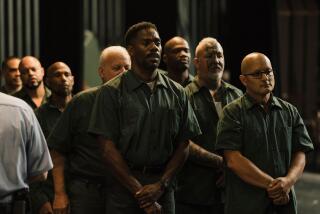Actor, Writer Spalding Gray Is Missing
- Share via
NEW YORK — Spalding Gray, an aristocratic-looking actor and writer best known for monologues such as “Swimming to Cambodia” and “Gray’s Anatomy,” has been missing from his New York home for seven days -- and family members feared the worst on Friday, given his bouts with depression and two suicide attempts.
Gray, 62, was supposed to visit a friend in Manhattan on Jan. 10 and board a flight to Denver the next day for a ski trip.
But he disappeared after taking his family to a movie and hasn’t been seen since, police spokesman Sgt. Kevin Hayes said.
The actor left his wallet and plane tickets behind in his Tribeca apartment and “then simply vanished,” said Sara Vass, a family friend and spokeswoman. “There is great worry, enormous concern that he be found alive,” she added, “because Spalding has been suffering from deep depression and had been fighting mightily on every front, physically and mentally.”
Gray’s wife, Kathleen Russo, and family friends are concerned especially over reports that a despondent-looking man resembling Gray was spotted on the night of his disappearance aboard the Staten Island ferry, perhaps getting ready to jump, Vass said. In September, she said, Gray had phoned his wife and said he was going to jump off the ferry; he had actually boarded it, but police were alerted and removed him.
Police have not been able to search the waters between Manhattan and Staten Island in recent days because of icy conditions, but temperatures are expected to warm in the next few days.
At the core of Gray’s unhappiness, friends said, was his slow recovery from painful injuries suffered in a 2001 automobile accident in Ireland. The actor had a series of operations to heal a fractured skull, brain damage, a shattered hip and other injuries. He had made progress in recent months, however, and was reportedly looking forward to being able to ski again.
Urbane, soft-spoken and keenly intelligent, Gray helped popularize the monologue as both a theatrical and cinematic art form in the 1980s, when he first began performing “Swimming to Cambodia,” a penetrating account of his role as a bit-actor in the movie “The Killing Fields,” about the rise of the Khmer Rouge in Cambodia.
Like other Gray monologues, the performance -- and its subject matter -- quickly expanded to include discourses on American foreign policy, religion, celebrity, mortality, sex and love. In later works, Gray used other autobiographical snapshots -- such as adolescence, his search for relief from intense eye pain and the difficulties in writing a novel -- as starting points for similarly dry, confessional monologues.
Despair was a constant theme in much of his work, and Gray admitted that he had difficulty coping with the year he turned 52 -- the age at which his mother committed suicide. More recently, he grappled with the impact of his accident in a new monologue, and he described his struggle in a 2002 interview with the Harvard University Gazette, saying: “It’s hard for me to speak, because I’m in a state of despair now.”
Recounting his accident, Gray said that a van had struck a car in which he and his wife were riding northeast of Dublin: “I flew forward, impacting my head on hers. Her seat came back.... I think what happened was the seat pushed my femur, dislocated my hip and fractured my skull. Next thing I know, I was in a puddle of blood on the road. It was an hour before the ambulance came. It changed my life.”
Gray, who was born in Rhode Island in 1941, first developed his storytelling skills with New York theatrical troupes in the 1970s. “Swimming to Cambodia,” his first big success, was made into a movie, as was “Gray’s Anatomy” and “Monster in a Box.” The actor also had roles in films including “Kate and Leopold,” “Beaches” and “The Paper.”
He most recently performed at Manhattan’s avant-garde Performance Space 122, where, from October to December, he staged “Life Interrupted,” a work-in-progress inspired by his accident.
Mark Russell, the theater’s executive artistic director who has known Gray since the 1970s, said the performer seemed pleased with the new monologue and was improving with each performance. He said Gray’s disappearance was out of character, despite his history of emotional problems.
“We’re all very worried,” Russell said Friday. “We hope he’s just playing cards in Vegas, looking for more material.”
Given Gray’s past, however, others were bracing for the worst. The actor “always had a death obsession,” according to Carey Perloff, artistic director of American Conservatory Theater in San Francisco, where Gray tried out some material about the car crash during a revival of “Swimming to Cambodia” in late 2001.
His disappearance “breaks my heart,” she added. “He’s such a survivor. But I worried about him when he was out here last time. You could feel that his creative energy ... was damaged.”
Times staff writer Elaine Woo contributed to this report.


